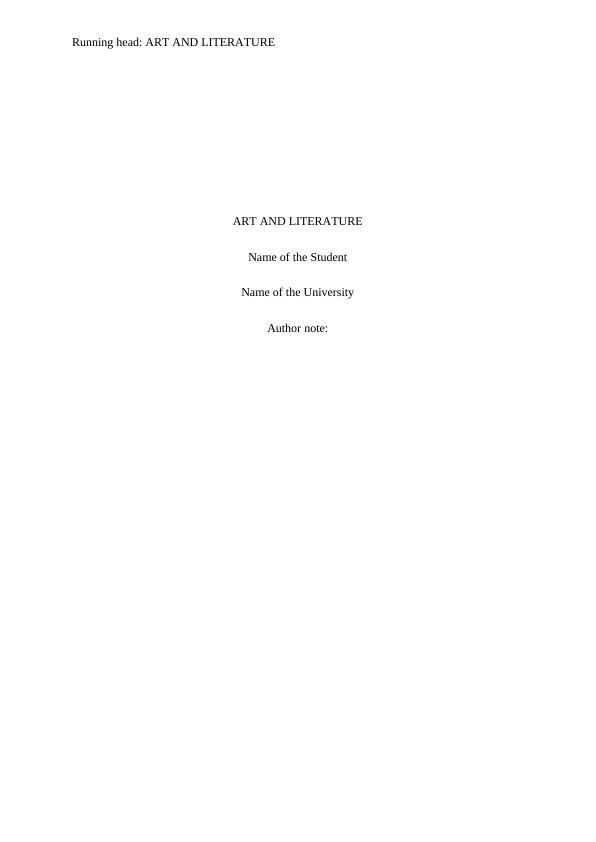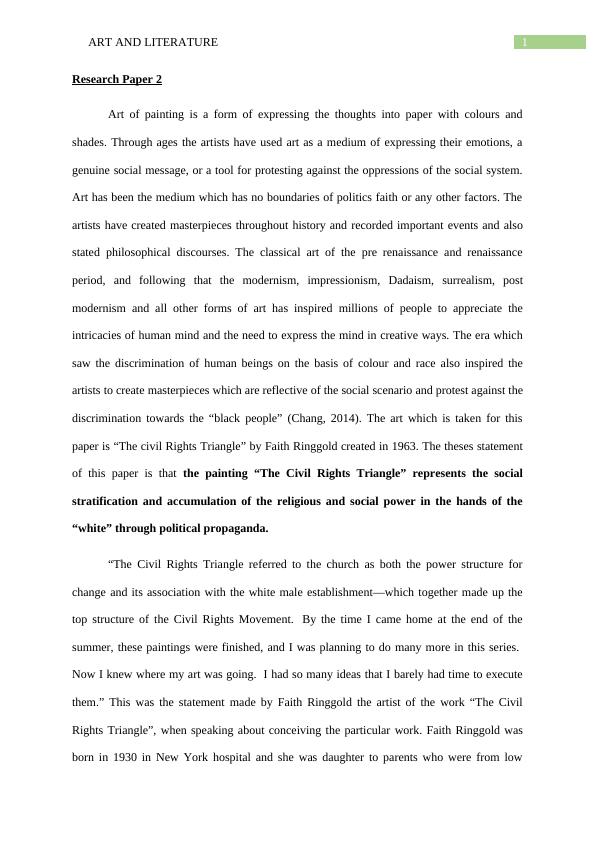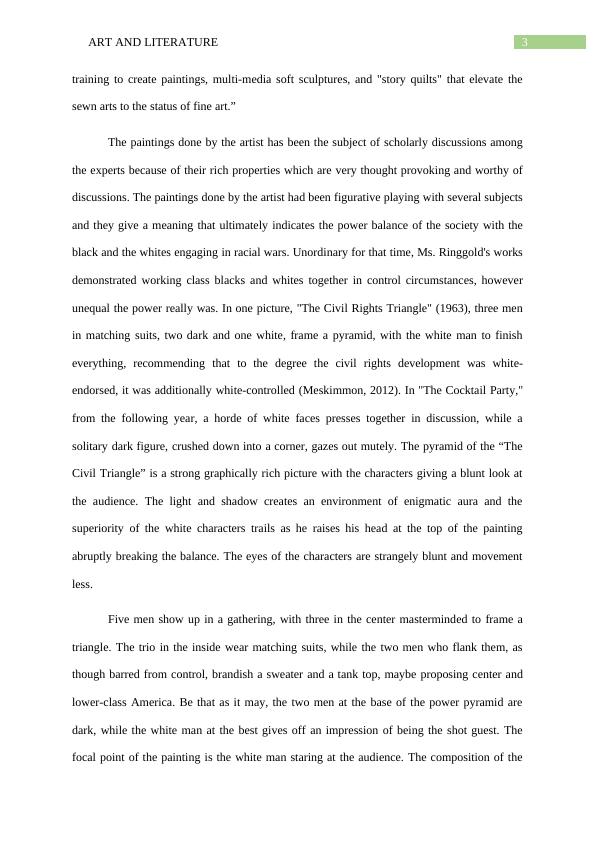Putting Black Culture on Stage - PDF
14 Pages4447 Words31 Views
Added on 2021-05-30
Putting Black Culture on Stage - PDF
Added on 2021-05-30
ShareRelated Documents
Running head: ART AND LITERATURE
ART AND LITERATURE
Name of the Student
Name of the University
Author note:
ART AND LITERATURE
Name of the Student
Name of the University
Author note:

1ART AND LITERATURE
Research Paper 2
Art of painting is a form of expressing the thoughts into paper with colours and
shades. Through ages the artists have used art as a medium of expressing their emotions, a
genuine social message, or a tool for protesting against the oppressions of the social system.
Art has been the medium which has no boundaries of politics faith or any other factors. The
artists have created masterpieces throughout history and recorded important events and also
stated philosophical discourses. The classical art of the pre renaissance and renaissance
period, and following that the modernism, impressionism, Dadaism, surrealism, post
modernism and all other forms of art has inspired millions of people to appreciate the
intricacies of human mind and the need to express the mind in creative ways. The era which
saw the discrimination of human beings on the basis of colour and race also inspired the
artists to create masterpieces which are reflective of the social scenario and protest against the
discrimination towards the “black people” (Chang, 2014). The art which is taken for this
paper is “The civil Rights Triangle” by Faith Ringgold created in 1963. The theses statement
of this paper is that the painting “The Civil Rights Triangle” represents the social
stratification and accumulation of the religious and social power in the hands of the
“white” through political propaganda.
“The Civil Rights Triangle referred to the church as both the power structure for
change and its association with the white male establishment—which together made up the
top structure of the Civil Rights Movement. By the time I came home at the end of the
summer, these paintings were finished, and I was planning to do many more in this series.
Now I knew where my art was going. I had so many ideas that I barely had time to execute
them.” This was the statement made by Faith Ringgold the artist of the work “The Civil
Rights Triangle”, when speaking about conceiving the particular work. Faith Ringgold was
born in 1930 in New York hospital and she was daughter to parents who were from low
Research Paper 2
Art of painting is a form of expressing the thoughts into paper with colours and
shades. Through ages the artists have used art as a medium of expressing their emotions, a
genuine social message, or a tool for protesting against the oppressions of the social system.
Art has been the medium which has no boundaries of politics faith or any other factors. The
artists have created masterpieces throughout history and recorded important events and also
stated philosophical discourses. The classical art of the pre renaissance and renaissance
period, and following that the modernism, impressionism, Dadaism, surrealism, post
modernism and all other forms of art has inspired millions of people to appreciate the
intricacies of human mind and the need to express the mind in creative ways. The era which
saw the discrimination of human beings on the basis of colour and race also inspired the
artists to create masterpieces which are reflective of the social scenario and protest against the
discrimination towards the “black people” (Chang, 2014). The art which is taken for this
paper is “The civil Rights Triangle” by Faith Ringgold created in 1963. The theses statement
of this paper is that the painting “The Civil Rights Triangle” represents the social
stratification and accumulation of the religious and social power in the hands of the
“white” through political propaganda.
“The Civil Rights Triangle referred to the church as both the power structure for
change and its association with the white male establishment—which together made up the
top structure of the Civil Rights Movement. By the time I came home at the end of the
summer, these paintings were finished, and I was planning to do many more in this series.
Now I knew where my art was going. I had so many ideas that I barely had time to execute
them.” This was the statement made by Faith Ringgold the artist of the work “The Civil
Rights Triangle”, when speaking about conceiving the particular work. Faith Ringgold was
born in 1930 in New York hospital and she was daughter to parents who were from low

2ART AND LITERATURE
income working class groups separated from their place of ancestry during the great
depression. She had the problem of Asthma from the very early stage of her life. Therefore
she instead of cultivating her interest on outdoor activities she had started experimenting with
colours and paintings. She stated “I grew up in Harlem during the Great Depression. This did
not mean I was poor and oppressed. We were protected from oppression and surrounded by a
loving family”. “Harlem” is a region in New York City which was the centre of residence of
the African American Community. People living in this region were discriminated and had to
face severe social stratification. It was the centre of many of the cultural and social
movements led by the Afro American Community.
Being raised in the Harlem area of New York at a time when the phenomenon of
racism was at its most, and being inflicted with the problem of Asthma and nurturing painting
due to the problem, she in future became a prominent artist who created many masterpieces
which led to the recognition of her as a famous artist of the era (Weatherford, 2014). Her
future works were greatly influenced by the “people, poetry, and music” she had encountered
in her younger age, also the effects of “racism, sexism, and discrimination” also had
influenced many of her works, which were created in the motive of spreading awareness
about social equality and justice. Her education happened in the “City College of New York”.
She had visited Europe for a tour where she visited France and had experienced several
artefacts and artworks at the Louvre museum, which had later inspired her to take up the
work called the “French collection”. The French collection was a renowned work of the artist
and one of her most acclaimed works. The artist also took up the art of quilt making, which
was traditionally connected to the slave culture, however she use this as a metaphor and used
the art of quilt making to depict the stories of discrimination and unequal status of the
“blacks” in the western society (Ringgold, 2012). According to her contemporary
commentator “She combines her African heritage and artistic traditions with her artistic
income working class groups separated from their place of ancestry during the great
depression. She had the problem of Asthma from the very early stage of her life. Therefore
she instead of cultivating her interest on outdoor activities she had started experimenting with
colours and paintings. She stated “I grew up in Harlem during the Great Depression. This did
not mean I was poor and oppressed. We were protected from oppression and surrounded by a
loving family”. “Harlem” is a region in New York City which was the centre of residence of
the African American Community. People living in this region were discriminated and had to
face severe social stratification. It was the centre of many of the cultural and social
movements led by the Afro American Community.
Being raised in the Harlem area of New York at a time when the phenomenon of
racism was at its most, and being inflicted with the problem of Asthma and nurturing painting
due to the problem, she in future became a prominent artist who created many masterpieces
which led to the recognition of her as a famous artist of the era (Weatherford, 2014). Her
future works were greatly influenced by the “people, poetry, and music” she had encountered
in her younger age, also the effects of “racism, sexism, and discrimination” also had
influenced many of her works, which were created in the motive of spreading awareness
about social equality and justice. Her education happened in the “City College of New York”.
She had visited Europe for a tour where she visited France and had experienced several
artefacts and artworks at the Louvre museum, which had later inspired her to take up the
work called the “French collection”. The French collection was a renowned work of the artist
and one of her most acclaimed works. The artist also took up the art of quilt making, which
was traditionally connected to the slave culture, however she use this as a metaphor and used
the art of quilt making to depict the stories of discrimination and unequal status of the
“blacks” in the western society (Ringgold, 2012). According to her contemporary
commentator “She combines her African heritage and artistic traditions with her artistic

3ART AND LITERATURE
training to create paintings, multi-media soft sculptures, and "story quilts" that elevate the
sewn arts to the status of fine art.”
The paintings done by the artist has been the subject of scholarly discussions among
the experts because of their rich properties which are very thought provoking and worthy of
discussions. The paintings done by the artist had been figurative playing with several subjects
and they give a meaning that ultimately indicates the power balance of the society with the
black and the whites engaging in racial wars. Unordinary for that time, Ms. Ringgold's works
demonstrated working class blacks and whites together in control circumstances, however
unequal the power really was. In one picture, "The Civil Rights Triangle" (1963), three men
in matching suits, two dark and one white, frame a pyramid, with the white man to finish
everything, recommending that to the degree the civil rights development was white-
endorsed, it was additionally white-controlled (Meskimmon, 2012). In "The Cocktail Party,"
from the following year, a horde of white faces presses together in discussion, while a
solitary dark figure, crushed down into a corner, gazes out mutely. The pyramid of the “The
Civil Triangle” is a strong graphically rich picture with the characters giving a blunt look at
the audience. The light and shadow creates an environment of enigmatic aura and the
superiority of the white characters trails as he raises his head at the top of the painting
abruptly breaking the balance. The eyes of the characters are strangely blunt and movement
less.
Five men show up in a gathering, with three in the center masterminded to frame a
triangle. The trio in the inside wear matching suits, while the two men who flank them, as
though barred from control, brandish a sweater and a tank top, maybe proposing center and
lower-class America. Be that as it may, the two men at the base of the power pyramid are
dark, while the white man at the best gives off an impression of being the shot guest. The
focal point of the painting is the white man staring at the audience. The composition of the
training to create paintings, multi-media soft sculptures, and "story quilts" that elevate the
sewn arts to the status of fine art.”
The paintings done by the artist has been the subject of scholarly discussions among
the experts because of their rich properties which are very thought provoking and worthy of
discussions. The paintings done by the artist had been figurative playing with several subjects
and they give a meaning that ultimately indicates the power balance of the society with the
black and the whites engaging in racial wars. Unordinary for that time, Ms. Ringgold's works
demonstrated working class blacks and whites together in control circumstances, however
unequal the power really was. In one picture, "The Civil Rights Triangle" (1963), three men
in matching suits, two dark and one white, frame a pyramid, with the white man to finish
everything, recommending that to the degree the civil rights development was white-
endorsed, it was additionally white-controlled (Meskimmon, 2012). In "The Cocktail Party,"
from the following year, a horde of white faces presses together in discussion, while a
solitary dark figure, crushed down into a corner, gazes out mutely. The pyramid of the “The
Civil Triangle” is a strong graphically rich picture with the characters giving a blunt look at
the audience. The light and shadow creates an environment of enigmatic aura and the
superiority of the white characters trails as he raises his head at the top of the painting
abruptly breaking the balance. The eyes of the characters are strangely blunt and movement
less.
Five men show up in a gathering, with three in the center masterminded to frame a
triangle. The trio in the inside wear matching suits, while the two men who flank them, as
though barred from control, brandish a sweater and a tank top, maybe proposing center and
lower-class America. Be that as it may, the two men at the base of the power pyramid are
dark, while the white man at the best gives off an impression of being the shot guest. The
focal point of the painting is the white man staring at the audience. The composition of the

End of preview
Want to access all the pages? Upload your documents or become a member.
Related Documents
Harlem Renaissance America Essay 2022lg...
|4
|1009
|36
The Harlem Renaissance | Arts and Humanitieslg...
|4
|613
|16
The Blacker The Berry: Impact of Racism and Hypocrisy on Societylg...
|6
|1897
|93
African American Studies: History, Struggle, and Developmentlg...
|10
|2534
|219
Medieval versus the Renaissance Periods PDFlg...
|5
|981
|22
